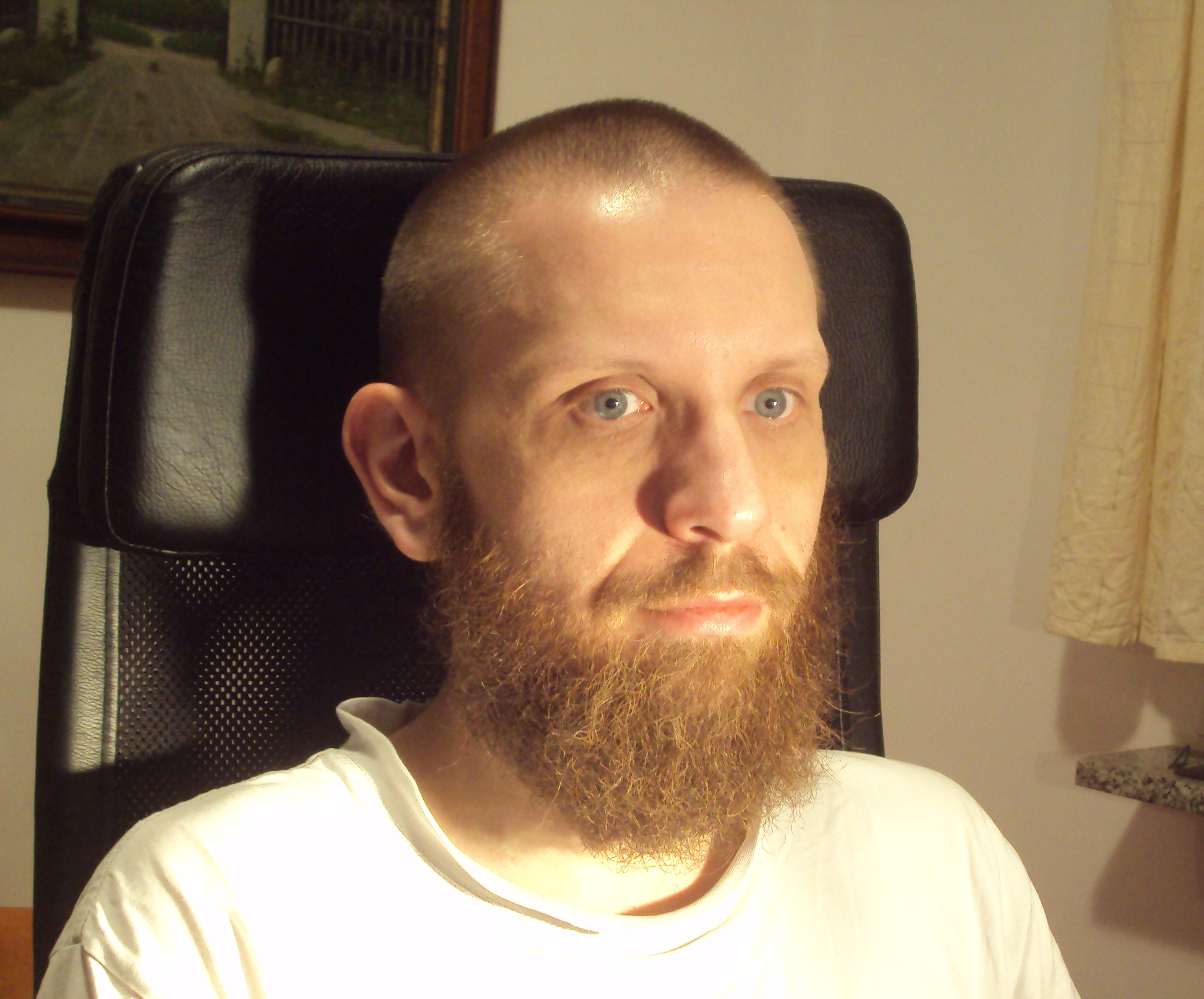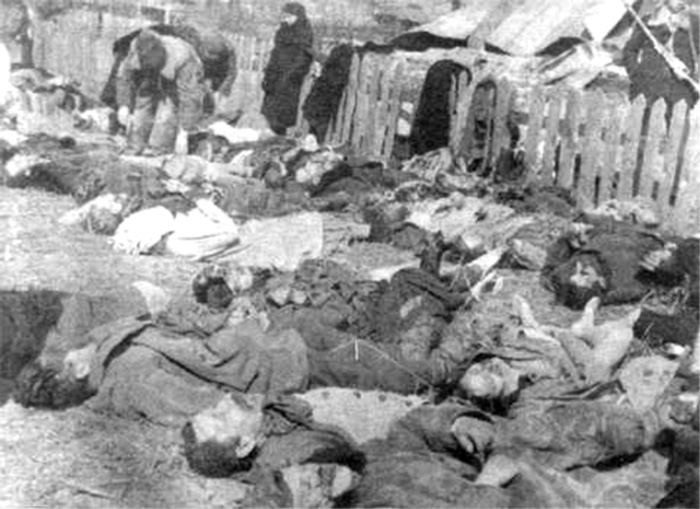|
Kisielin Massacre
Kisielin massacre was a massacre of Polish worshipers which took place in the Volhynian village of Kisielin ( Second Polish Republic until 1939), now Kysylyn, located in the Volyn Oblast, Ukraine. It took place on Sunday, July 11, 1943, when units of the Ukrainian Insurgent Army (UPA), supported by local Ukrainian peasants, surrounded Poles who had gathered for a ceremony at a local Roman-Catholic church. Around 60 to 90 persons or more, men, women and children – were ordered to take off their clothes and were then massacred by machine gun. The wounded were killed with weapons such as axes and knives. Those who survived (around 200 by some accounts) escaped to the presbytery and barricaded themselves for eleven hours. Background Kisielin massacre was part of a wave of the Ukrainian OUN-UPA massacres of Poles in Volhynia carried out between 1943 and 1944 during World War II. Among its survivors were parents of Polish composer Krzesimir Dębski, who in the early 2000s accompa ... [...More Info...] [...Related Items...] OR: [Wikipedia] [Google] [Baidu] |
Polish Second Republic
The Second Polish Republic, at the time officially known as the Republic of Poland, was a country in Central and Eastern Europe that existed between 1918 and 1939. The state was established on 6 November 1918, before the end of the First World War. The Second Republic ceased to exist in 1939, when Poland was invaded by Nazi Germany, the Soviet Union and the Slovak Republic, marking the beginning of the European theatre of the Second World War. In 1938, the Second Republic was the sixth largest country in Europe. According to the 1921 census, the number of inhabitants was 27.2 million. By 1939, just before the outbreak of World War II, this had grown to an estimated 35.1 million. Almost a third of the population came from minority groups: 13.9% Ruthenians; 10% Ashkenazi Jews; 3.1% Belarusians; 2.3% Germans and 3.4% Czechs and Lithuanians. At the same time, a significant number of ethnic Poles lived outside the country's borders. When, after several regional conflicts, the b ... [...More Info...] [...Related Items...] OR: [Wikipedia] [Google] [Baidu] |
Ukrainian Insurgent Army
The Ukrainian Insurgent Army ( uk, Українська повстанська армія, УПА, translit=Ukrayins'ka povstans'ka armiia, abbreviated UPA) was a Ukrainian nationalist paramilitary and later partisan formation. During World War II, it was engaged in guerrilla warfare against the Soviet Union, the Polish Underground State, Communist Poland, and Nazi Germany. It was established by the Organization of Ukrainian Nationalists. The insurgent army arose out of separate militant formations of the Organization of Ukrainian Nationalists—Bandera faction (the OUN-B), other militant national-patriotic formations, some former defectors of the Ukrainian Auxiliary Police, mobilization of local populations and others.Vedeneyev, D. Military Field Gendarmerie – special body of the Ukrainian Insurgent Army'. "Voyenna Istoriya" magazine. 2002. The political leadership of the army belonged to the OUN-B. It was the primary perpetrator of the ethnic cleansing of Poles in Volhy ... [...More Info...] [...Related Items...] OR: [Wikipedia] [Google] [Baidu] |
Telewizja Polska
Telewizja Polska S.A. (; "Polish Television"; TVP), also known in English as the public Polish Television is a Polish state media corporation. It is the largest Polish television network, although viewership has been declining in the 2010s. Since 1993, the legal status of the broadcaster has been defined by the Broadcasting Act, according to which Telewizja Polska is obliged to implement "a public mission ... by offering ... various programmes and other services in the field of information, journalism, culture, entertainment, education and sport, characterized by pluralism, impartiality, balance and independence as well as innovation, high quality and integrity of the message." Since 2016, TVP has been described by critics as providing one-sided favorable coverage of the ruling Law and Justice party. Timeline of Polish TV service * 1935: The PIT (Państwowy Instytut Telekomunikacyjny - National Telecommunications Institute) starts working together with Polish Radio on establis ... [...More Info...] [...Related Items...] OR: [Wikipedia] [Google] [Baidu] |
Warszawa
Warsaw ( pl, Warszawa, ), officially the Capital City of Warsaw,, abbreviation: ''m.st. Warszawa'' is the capital and largest city of Poland. The metropolis stands on the River Vistula in east-central Poland, and its population is officially estimated at 1.86 million residents within a greater metropolitan area of 3.1 million residents, which makes Warsaw the 7th most-populous city in the European Union. The city area measures and comprises 18 districts, while the metropolitan area covers . Warsaw is an Alpha global city, a major cultural, political and economic hub, and the country's seat of government. Warsaw traces its origins to a small fishing town in Masovia. The city rose to prominence in the late 16th century, when Sigismund III decided to move the Polish capital and his royal court from Kraków. Warsaw served as the de facto capital of the Polish–Lithuanian Commonwealth until 1795, and subsequently as the seat of Napoleon's Duchy of Warsaw. The ... [...More Info...] [...Related Items...] OR: [Wikipedia] [Google] [Baidu] |
Ewa Siemaszko
Ewa Siemaszko is a Polish writer, publicist and lecturer; collector of oral accounts and historical data regarding the Massacres of Poles in Volhynia. An engineer by profession with Master's in technological studies from the Warsaw University of Life Sciences, Siemaszko worked in public health education and also as a school teacher following graduation. She is a daughter of writer Władysław Siemaszko with whom she collaborates and shares strong interest in Polish World War II history. From 1990 Ewa Siemaszko collected and prepared documents regarding the ethnic cleansing that took place in Volhynia during the Second World War. She is the co-author of a 1992 exhibition at the Warsaw Museum of Independence regarding the atrocities committed by the NKVD in and around the Polish Kresy region in 1941; and, an exhibit "Wolyn or our ancestors" organised in 2002 at the Dom Polonii in Warsaw. She also collaborates with the Society of Volyn and Polissia at the Polish Institute of Nation ... [...More Info...] [...Related Items...] OR: [Wikipedia] [Google] [Baidu] |
Władysław Siemaszko
Władysław Siemaszko (born 8 June 1919) is a Polish publicist and lawyer, former member of the Polish resistance Armia Krajowa (AK), author of numerous publications focusing on the massacres of Poles in Volhynia. He is the father of writer Ewa Siemaszko, co-author of ''Ludobójstwo dokonane przez nacjonalistów ukraińskich na ludności polskiej Wołynia 1939–45'' (The Genocide Committed by the Ukrainian Nationalists on Polish Citizens of Volhynia in 1939–45) consisting of two volumes of 1500 pages of research. Life Siemaszko was born in Curitiba, Brazil, to a Polish diplomat who was sent there by the Second Polish Republic to a diplomatic post. Władysław moved with his family back to Poland in 1924, and settled in Wołyń Voivodeship. The Siemaszko family had lived in Volhynia since January Uprising of 1863, after which Wladyslaw's grandfather bought some land from the Ukrainians in the area of Volodymyr-Volynskyi. Władysław Siemaszko joined the 27th Volhynian Divi ... [...More Info...] [...Related Items...] OR: [Wikipedia] [Google] [Baidu] |
Marek Jerzy Minakowski
Marek Jerzy Minakowski is a Polish historian and genealogist Genealogy () is the study of families, family history, and the tracing of their lineages. Genealogists use oral interviews, historical records, genetic analysis, and other records to obtain information about a family and to demonstrate kins ... known for creating the Polish genealogy database ''Wielka Genealogia Minakowskiego.'' Early life and career Minakowski earned his PhD in classical philosophy at the Jagiellonian University, Kraków. Initially focusing on classical philosophy and logics, he later started publishing about Poland's history and genealogy. In 2001, he founded a genealogy website ''Wielka Genealogia Minakowskiego'' and began adding available historical records. By 2020, the site contained genealogy records of around 1 million people. In 2016, in recognition of his work, he received the Decoration of Honor Meritorious for Polish Culture. Personal life In 1994, he married archaeologist ... [...More Info...] [...Related Items...] OR: [Wikipedia] [Google] [Baidu] |
Agnieszka Arnold
Agnieszka Arnold (born 24 September 1947 in Łowicz) is a Polish documentary filmmaker born 1947. She compiled two documentaries on the Jedwabne pogrom of Jewish villagers, during World War II World War II or the Second World War, often abbreviated as WWII or WW2, was a world war that lasted from 1939 to 1945. It involved the vast majority of the world's countries—including all of the great powers—forming two opposing ..., by their Polish neighbors. Films * '' Miś'' (1980) - Assistant director * ''Kto ziarno nadziei siał'' (1993) * ''Anoszim, noszim, we-taf...'' (1993) * ''Mit, tradycja, rzeczywistość'' (1994) * ''Miasteczko'' (1995) * ''Oberek'' (1996) * ''Ocalona'' (1996) * ''Bareizm'' (1997) * ''Na początku była Trzcinica'' (1997) * ''...Gdzie mój starszy syn Kain'' (1999) * ''Ikona Bożego Narodzenia'' (2000) * ''Czarny lipiec'' (2001) * ''Sąsiedzi'' (2001) * ''Bohater'' (2002) - on Romuald Rajs * ''Historia matematyka polski'' (2003) * ''Oczysz ... [...More Info...] [...Related Items...] OR: [Wikipedia] [Google] [Baidu] |
Krzesimir Dębski
Krzesimir Marcin Dębski (; born 26 October 1953 in Wałbrzych) is a Polish composer, conductor and jazz violinist. His music career as a musician has been that of a performer as well as composer of classical music, opera, television and feature films. Professional career Krzesimir Dębski studied composition with Andrzej Koszewski, and conducting with Witold Krzemieński, at the Paderewski Academy of Music in Poznań, Poland. Following graduation, Dębski became interested in jazz. Since 1982, as the leader and violinist of the jazz group ''String Connection'', he has performed in the United States, Canada and over 25 countries in Europe. In 1986 Dębski has cut down on his concert performances and concentrated primarily on composition. He has composed more than 60 symphonic and chamber music pieces, including an opera, 2 symphonies, religious works and 9 instrumental concertos. Since 1986, he has composed the music for over 70 films, received 8 platinum albums and has compose ... [...More Info...] [...Related Items...] OR: [Wikipedia] [Google] [Baidu] |
Massacres Of Poles In Volhynia
The massacres of Poles in Volhynia and Eastern Galicia ( pl, rzeź wołyńska, lit=Volhynian slaughter; uk, Волинська трагедія, lit=Volyn tragedy, translit=Volynska trahediia), were carried out in German-occupied Poland by the Ukrainian Insurgent Army, or the UPA, with the support of parts of the local Ukrainian population against the Polish minority in Volhynia, Eastern Galicia, parts of Polesia and Lublin region from 1943 to 1945. The peak of the massacres took place in July and August 1943. Most of the victims were women and children. Many of the Polish victims regardless of age or gender were tortured before being killed; some of the methods included rape, dismemberment or immolation, among others. The UPA's actions resulted in between 50,000 and 100,000 deaths. According to Timothy Snyder, the ethnic cleansing was a Ukrainian attempt to prevent the post-war Polish state from asserting its sovereignty over Ukrainian-majority areas that had been part of th ... [...More Info...] [...Related Items...] OR: [Wikipedia] [Google] [Baidu] |
OUN-UPA
The Ukrainian Insurgent Army ( uk, Українська повстанська армія, УПА, translit=Ukrayins'ka povstans'ka armiia, abbreviated UPA) was a Ukrainian nationalist paramilitary and later partisan formation. During World War II, it was engaged in guerrilla warfare against the Soviet Union, the Polish Underground State, Communist Poland, and Nazi Germany. It was established by the Organization of Ukrainian Nationalists. The insurgent army arose out of separate militant formations of the Organization of Ukrainian Nationalists—Bandera faction (the OUN-B), other militant national-patriotic formations, some former defectors of the Ukrainian Auxiliary Police, mobilization of local populations and others.Vedeneyev, D. Military Field Gendarmerie – special body of the Ukrainian Insurgent Army'. "Voyenna Istoriya" magazine. 2002. The political leadership of the army belonged to the OUN-B. It was the primary perpetrator of the ethnic cleansing of Poles in Volh ... [...More Info...] [...Related Items...] OR: [Wikipedia] [Google] [Baidu] |





.jpg)